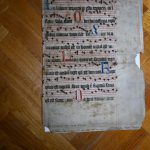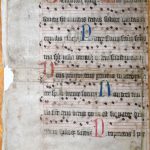In the 1770s, Empress Maria Theresia founded new bishoprics in Hungary. In 1777 the Diocese of Székesfehérvár was created from a part of the Veszprém Diocese. In the Middle Ages, Székesfehérvár did not have episcopal rank: it functioned as a collegiate chapter. Ottokár Prohászka, appointed in the early 1900s, was succeeded in 1927 by Lajos Shvoy as bishop of Székesfehérvár. During his time the library was rearranged, mainly by István Kuthy (1889–1966), whose work was assisted by Béla Fehér (1890–1939), a polyhistor, book collector, and parish priest of Szigetcsép and later Vértesboglár. Fehér looked for old books and artifacts from the parishes of the diocese, which were later transferred to the Diocesan Library and the Diocesan Museum, founded in 1938.
The codex leaf under examination, which was formerly owned by Béla Fehér is a detached folio of a late 15th-century sequentionary. This explains the black ink inscription at the bottom of the recto: ‟Property of the Diocesan Archives of Székesfehérvár. A gift of Béla Fehér, parish priest of Szigetcsép. September 1936”. Fehér was transferred to Vértesboglár in 1936, presumably in the autumn, which is why the September entry still refers to him as the parish priest of Szigetcsép (a village that was part of the Csepel district of the Székesfehérvár Diocese). The autumn date of the transfer is confirmed by the fact that the former possessor and the gift are already mentioned in fragment F 975 as follows: “Gift of Béla Fehér, pleb. of Vértesboglár, December 1936”.
Unfortunately, this is all that can be learned about the history of the medieval leaf, everything else is up to fragment analysis. There are foldings at the margins and faint traces of a spine in the middle of the leaf, so it must have been a book cover. It is not clear what was bound into the parchment. The fragment is now in the library without a label.
The notation is familiar at first glance, narrowing down the provenance. In this case, the musical script also reveals the date of birth of the manuscript and the institution that produced and used it. The notation of the Pozsony/Bratislava antiphoners (“Knauz 4–5 antiphoners” as this chant manuscripts are known in the Hungarian plainchant literature) written for the St Martin collegiate chapter in Pozsony/Pressburg/today Bratislava in 1487–1488 is seen in the fragment. The RISM-sign of the first codex („Knauz-4”) is SK-BRsa SNA 4, see http://cantus.sk/source/3192. The „Knauz-5” antiphoner is also known as ‟Han Codex” after its illuminator (see http://cantus.sk/source/12363, RISM: SK-Bra BAIIa EC Lad. 4). The same musical notation is hidden at the end of the Bratislava “G” missal (H-Bn Clmae 219) preserved in the National Széchényi Library in Budapest. In recent years, the same notation has been identified on several codex fragments, too, and it is high time to analyze them and compare them to the truncated Kn 4–5 codices and the missal to explore their interrelations.
The musical notation of the sequentionary leaf can be defined as Messine-German Gothic notation, an elaborated writing, standardized in all its elements, which refers to the use of a representative church. The staves of four red lines are relatively short, the layout is airy. The scribe has left wide margins at the edges, sparing no space. The nine staves shown here are not the full folio size, as the first line has been cut in half, and additional staves can be expected. Several striking features of the layout are noteworthy. The rastrum does not usually extend to the vertical outer bounding line. At the front, between the two bounding lines, there are C-clefs, while at the end of the staves, a pipe-shaped custos appears. There are no elements of the earlier Esztergom notation, which does not in any way rule out the possibility that it is a Hungaricum: this Gothic notation was often used in medieval Upper Hungary (today Slovakia), and its use covered a vast area east of the Rhine, significantly transforming the chant notation of Central Europe at the end of the Middle Ages.
The Hungarian provenance of the fragment is not revealed by the liturgical content itself (commonly used sequences) or by the melodies, but by the unmistakable musical script, the main characteristic of which is that the punctum has an elongated, rectangular form, placed obliquely onto the staves. In the case of neumes of more notes (e.g. clivis) punctum forms a regular rhombus shape. In downward movement, the placement of the text syllables would cause the independent notes to confuse with the climacus, which was subsequently eliminated by drawing a thin stem at the beginning in the case of climacus. This thin stem of the climacus is a feature of all manuscripts in this source.
The study of the large initial letters, decorated with special pen drawings at the beginning of some chants, offers an opportunity for art historical analysis, although these have been slightly peeled off from the fragment and faded away by the book cover function. On the outside (probably on the verso folio) were the initials B and P. The decoration is perfectly identical to the motif set of other pen drawings in the Pozsony source group.
In addition to the codices, the common notation unites about seven fragments: corresponding fragments have been found in Budapest and Sopron (Budapest, ELTE University Library and Archives: Fr. l. m. 282 – F 823; Fr. l. m. 283 – F 824; Fr. l. m. 288 – F 829; Fr. l. m. 289 – F 830; Pauline Library of the Central Seminary: Fr. l. m. 128, Sopron State Archives: 121 VI. 8 (598). Even the first overview showed that the characteristic notation does not refer to isolated manuscripts, but the same scribe, workshop, and date. It is probable that parts of interrelated pair-codices have come to light, i.e. the Pozsony antiphoners of the St Martin collegiate chapter from the 1480s, together with parts of a volume containing Mass chants.
However, our recent research is also important from the perspective of the Han Codex. Janka Szendrei regretted that the corpus preserved in Bratislava today has suffered considerable damages, has been mutilated and its ornate initials have been excised (Janka Szendrei, A magyar középkor hangjegyes forrásai [Notated Sources of the Hungarian Middle Ages]. Studies in Hungarian Music History 1. Budapest: Institute for Musicology of the HAS, 1981, 37). The antiphoners may have been popular bookbinding material, which is proved by a newly found fragment of the codex (see the digital photo collection of the Sopron State Archives in the Early Music History Department of the Institute of Musicology, Budapest), and the discovery also supports Szendrei’s lines about the dubious popularity of the deluxe codex leaves as book covers after the Middle Ages.
It seems that the gradual and the sequentionary were more unfortunate than the antiphoners: not even a torso survived, and only the fragments that have now been found testify to their existence. The book types of these fragments can be summarised as follows, according to the current state of research: one fragment, Mass proper, Gradual – ELTE University Library and Archives; one fragment, Kyriale – ELTE University Library and Archives; three fragments, Sequentionary, two at the ELTE University Library and Archives and one in the Pauline Library.
While the dimensions and the small details support the close relationship between the fragments and the above-mentioned codices, their relationship to the Székesfehérvár fragments is somewhat uncertain. The three sequentionary leaves (i.e. the ones from the ELTE University Library and Archives and the Pauline Library) differ somewhat in size from the Székesfehérvár leaf, e.g. the spaces for the chant texts are slightly wider. It is puzzling that the height of the staff is the same, as is the style and decoration of the folios (see, for example, the already mentioned letters B and P, the illuminations of which are identical in all sources). There are two possible explanations: 1. we have found a part from another sequentionary, made by the workshop in Bratislava for another commission at the end of the 15th century, 2. this fragment belongs to the newly discovered codex series as well, but there is a difference in the execution of the temporal and the sanctoral part (the other three fragments includes the chants for the feasts Inventio S. Crucis and Ioannes ante portam Latinam (Laudes crucis attollamus, Verbum Dei).
It is possible that the melodies could fit into two volumes (this is not inconceivable, given the four antiphoners). The fragment from Székesfehérvár contains the Pentecostal Veni Sancte Spiritus sequence (…from dulcis hospes animae to the end) and the Benedicta sit for Trinity Sunday (from the beginning to Da tuis fidelibus in te).
It is gratifying that, after the earlier discoveries made in Nagyszombat/Trnava, musical fragmentology has once again opened the way to another important series of 15th-century Northern Hungarian codices, and thus to a closer understanding of the international character of the late 15th-century musical codex art of Pozsony/Bratislava. Based on the host books, possessors, and the details of the notations, e.g. by the stems of the downward climacus, it seems that the antiphoners and their pair gradual(s) of the 1480s were for a long time in Pozsony, and after the Council of Trent, its leaves were used as covers of books that were later kept to their temporary home of the Archbishop of Esztergom, in Nagyszombat/Trnava (see, for example, the owners of the University and Pauline Library).
Gabriella Gilányi



